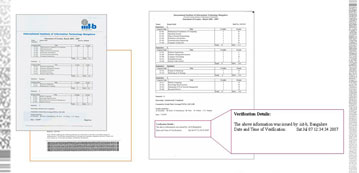HP Labs India
| Document Authentication System (DAS) |
 |
HP Labs India's Document Authentication System (DAS) addresses
the problem of document authentication to overcome fraud
and forgery. The DAS uses a 2D barcode in a networked environment
to accomplish the validation of a document.
A 2D barcode can hold a large amount of machine readable
data and can also be printed on paper. Documents that need
authentication, like educational transcripts, driver’s
license, citizens ID card etc. would include a 2D barcode
generated by the DAS system. This, when it is presented
as a legally valid document and needs to be authenticated,
can be read using commonly available scanners. The scanned
document can be sent to the DAS system over a network which
generates a report stating the validity of the concerned
document. A central DAS system can serve multiple users
over a network such as the Internet.
The integrity of the document is validated using the content
decoded from the barcode to the Document Authentication
System (DAS). The DAS incorporates security features to
ensure that the contents of the barcode are not tampered
with. The client side software prints out a verification
statement which contains the information decoded from the
barcode along with a statement from the server indicating
that the barcode's contents are authentic. The comparison
of this information with the information on the original
document can be used to detect forgery or manipulation very
early in an attempted fraud. The verification statement,
containing full information, can be processed by itself
without even comparing it with the original human-readable
text. The Document Authentication System also protects the
privacy of the end users whose documents are being verified.
DAS is not complicated to implement and is intuitive to
use. It is designed to blend into the existing paper ecosystem.
While giving security to documents, it does not take away
the positive aspects of the paper medium - simplicity and
familiarity. It also addresses the concerns of privacy of
individuals.
To know more about DAS, click here to download the whitepaper
This page was last updated on November 24, 2009